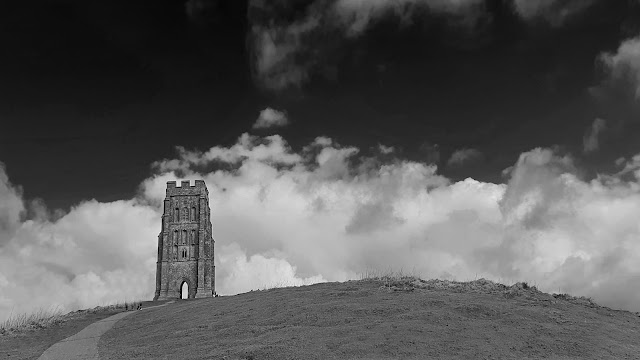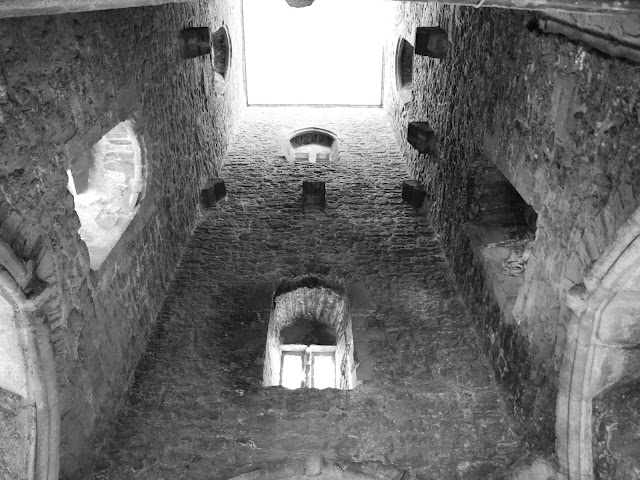Over the last few years we have been coming to the Somerset Levels on a more regular basis, the RSPB Ham Wall reserve and the Shapwick Heath NNR being the main attraction , mostly in the winter when there is the opportunity to see the Starling murmurations. On those visits one feature of the landscape that dominates the area is the Glastonbury Tor. The tor is a hill that is just outside the town of Glastonbury. The hill is just over 500 feet high and is topped by St Michaels Tower, a roofless tower, that is all that remains of the St Michael's Church that was built back in the 14th century
We were back in Somerset once again and this time we decided to climb the tor and to see the Levels from the tor, rather than looking at the tor from the Levels. The weather was perfect, blue skies and white puffy clouds, plus clear skies which meant the the visibility from the top of the tor would be excellent. Starting from the centre of Glastonbury, the route to the tor is signposted and takes you along residential streets before the path starts to rise through woodland and open fields that had sheep and lambs grazing. Looking back the church of St John the Baptist dominates the skyline of Glastonbury looking west.
The Tor and tower then became visible through the trees.
What then became apparent was that we were following a route that would take us up the Tor via the steepest slope, and this was not what we wanted to do. Fortunately we were able to detour and walk across another field with lambs and pick up the main concreted path that has a much gentler incline up to the tower.
The distinctive shape of the tor is due to a combination of the unusual geology and the artificial terraces. The conical hill is of clay and blue lias a geological formation of limestone and shale, rises from the Somerset Levels. It was formed when surrounding softer deposits were eroded, leaving the hard cap of sandstone exposed. The slopes of the hill are terraced, but the method by which they were formed remains unexplained, one of the theories is that they were formed to aid the climb to the top of the tor
Half way up there is a bench that looks out towards the west over the towns of Glastonbury and Street and a way towards the Bristol Channel. The visibility was so good it was possible to make out the monolith of the Hinckley nuclear power station
Archaeological excavations during the 20th century sought to
clarify the background of the monument and church, but some aspects of their
history remain unexplained. Artefacts from human visitation have been found,
dating from the Iron Age to Roman eras. Several buildings were
constructed on the summit during the Saxon and early medieval
periods; they have been interpreted as an early church and monks' hermitage.
The head of a wheel cross dating from the 10th or 11th century has
been recovered.
The original wooden church was destroyed by an
earthquake in 1275, and the stone Church of St Michael was built on the site in
the 14th century. Its tower remains, although it has been restored and
partially rebuilt several times.
This iconic hill has been a spiritual magnet for centuries, for both Pagans and Christians. Tales have grown out of history, becoming
blended and embellished leaving the truth, whatever it was, literally lost in
the mists of Avalon.
Beneath the hill, it is said, that there is a hidden cave through which you can pass in to the fairy realm of Annwn. There dwells the lord of the Celtic underworld Gwyn ab Nudd with the Cauldron of Rebirth. Glastonbury has a long tradition of being a gateway into "The Land of the Dead (Avalon)". This ‘Isle of Avalon’ is where King Arthur supposedly went after his last battle. The monks of Glastonbury Abbey claimed to have actually found his grave in 1191.
Later tradition has it that here lies the Holy Grail brought here by Jesus’s uncle, Joseph of Arimathea. The Cauldron and the Grail were both the object of quests for King Arthur and his knights. Jesus is said to have come to Glastonbury as a boy, traveling here with Joseph of Arimathea. Joseph was a tin merchant and had travelled to the South-West for this valuable metal. This legend inspired William Blake to write the famous poem ‘Jerusalem’: 'And did those feet in ancient time; walk upon England’s mountains green? And was the Holy Lamb of God, on England’s pleasant pastures seen?'
Finally, The Tor and other sites in Glastonbury have also been significant in the modern-day Goddess movement, with the flow from the Chalice Well seen as representing menstrual flow and the Tor being seen as either a breast or the whole figure of the Goddess. This has been celebrated with an effigy of the Goddess leading an annual procession up the Tor
It is also said that Brigid of Kildare, one of the three national
saints of Ireland, the ‘mother saint’ is depicted in a stone carving above
one of the entrances to the tower, milking a cow
We were not alone at the top, there were several groups one or two who seemed to be taken by the spiritual nature of the place and were claiming to feel the natural vibrations emanating from the ground beneath.
We were there for the view though and it was quite spectacular as you took in 360 degrees of the Somerset Levels and Mendip Hills away to the north.
Here looking east
The tower itself is just that a tower. It is roofless but you are able to walk through it.
The view through the west facing arch.
Looking up from inside the tower.
Heading back down the hill, another view of the Tower.

















No comments:
Post a Comment